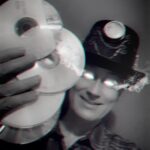If nothingness is real, there is room everywhere for it. In fact, there is no place nothingness never was. What exactly is nothingness? There’s always room for ice cream. Is there always room for nothingness? I think there is. In fact, I think nothingness is actually a whole lot of something. And I think that something is the very reason awesomeness is truly maximized. That’s what we’ll talk about today. Ready?
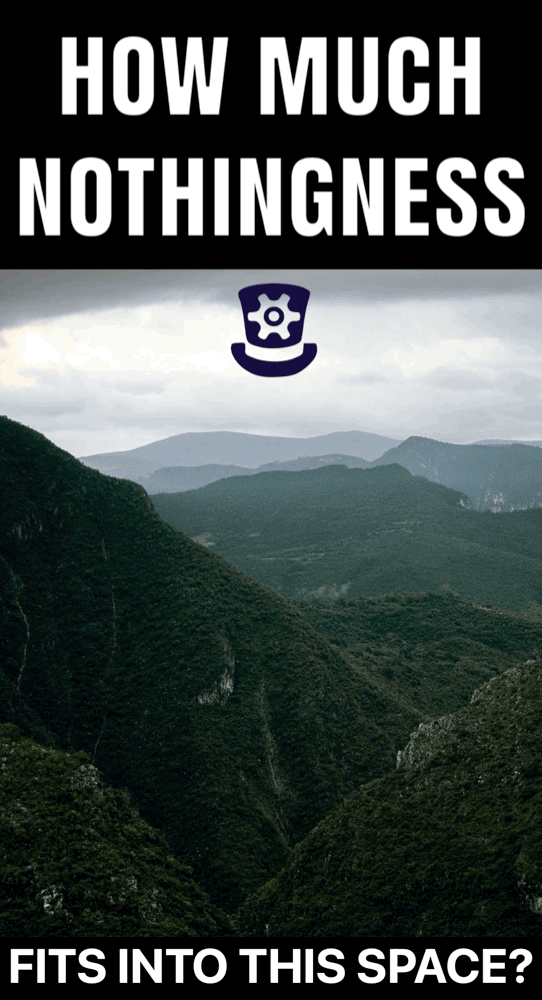
A search on YouTube asking about what nothingness is, will provide some fascinating results. From the perspective of a physicist, there is a lot of something involved in nothingness. For instance, you might take a gander at The Nature of Nothing from the Great Courses Plus series on the PBS Space Time channel.
The way a philosopher might view nothingness is different than the way a physicist might, but the two fields are related. The word Metaphysics includes the word “physics” for a reason. Physics started out as a branch of philosophy. Metaphysics is the branch of philosophy that talks about how we got here and what the Universe is and what we are. To the extent that any of these questions might involve awesomeness, Pamalogy – Poly Astronomically Maximized Awesomeology, wants to know too. Pamalogists consider various reasons for believing in the Multiverse and we think on the implications of the maximization of awesomeness.
Today, in considering absolute nothingness, and in pointing out that there is room for it everywhere and at all times, I’m going to take a very different view than most of today’s phsycists do. When a modern physicist looks at this question, they’ likely consider the possibility of nothingness and want to know whether it is possible to make it happen in any particular portion of space. But that’s not actually the nothingness I’m talking about. What they’re thinking about is a vacuum. They are thinking about the absence of anything in the dimensions of a Universe that otherwise contains a lot of various types of particles and fields. They have names for all those tiny things and the laws that help describe them. There is a lot they agree on nowadays. Most won’t think that an absolute vacuum is possible. Most also see time as relative to space and matter, so they have no problem viewing the big bang as the beginning of time.
But when I say “there is room for nothingness everywhere and at all times,” I am referring to something very specific. So, forget physics for a few moments and allow me to offer some philosophical considerations. Forget that a vacuum might be impossible, given what we know about physics. Let’s start with a different sort of something that nothingness has. Namely, supposing nothingness in all places was possible – nothing but nothingness anywhere – pretend that it waqs possible. If so, then what would still exist?
While you might think the answer is nothing. That’s not true. Math and logic would still exist. The truth of all possibility would exist.
That’s the nice thing about pure possibility. It doesn’t require time or space. It just is. What remains when no Universe or any of the phenomena or laws the phsycists describe, is abstract truth – pure truth.
So, right about now you may be uttering to yourself something attributed to Pontius Pilot, “what is truth?”
One way of answering that question is to say that logic and math are truth. Math deals with hypotheticals and conditions. If there is one of something and another of the same thing, then there are two of that thing. It’s a conditional statement – if/then. If x, then x+x =2x. It’s logic. 2x = x+x. So, in the event that x is true, 2x would mean x+x and x+x would mean 2x.
It might be argued that there can’t be any such thing as 2x because whatever is a second x can’t be the first x. It’s not really x. It’s x’ In philosophy, we look for very precise meaning. If I tell you that a = b, then I’m probably talking about some way in which “a” is the same as “b”. For instance, if I say 2x = a and I say b = x+x, then I can say that “a” represents the same number of “x” as b does, but sameness is relative. That is, in counting x, are we counting the same x, or different x’s that happen to be of the same kind or type? X1 X2, and so on?
Don’t let that sort of question bother you. For the sake of the point I’ll be making today, none of that matters. We may be imprecise when we make assumptions in our mathematics, supposing x means x, when it actually means X1 or X2, but when it comes to the question of “what is truth?” I’m not referring to our personal inaccuracies. I’m referring to what would actually be true under various possible conditions – whatever that may be. So if I tell you that “math and logic are truth,” I’m not talking about inaccurate math and logic. I’m talking about correct and accurate math and logic – and I’m not pretending I have the capacity to convey whatever that is.
There are many forms of math and logic. Today I want to beam in on something called counterfactuals. Counterfactuals involve the would be’s and could be’s of logic. If there were two “X”s, then X+X= 2X, or 2X is true. If A, then A. If B, then B. A counterfactual is a conditional statement that begins with the truth that “x” is a hypothetical possibility. Whatever x may represent, the fact that x is a hypothethical possibility remains true.
Because hypothetical possibility requires no space or reality, it fits into nothingness.
So, what I’m telling you then, is that even if it was true that throughout all Universes, there was absolute nothingness, that there would still be something, and I’m not referring to the particles or fields physicists are referring to when they say something similar. What I’m saying would remain is the total set of possibility.
Applying this to my opening statement then, that there is always room for nothingness everywhere, since there is indeed something even in nothing, namely all possibility, truth is a constant that exists in all places at all times in all Universes.
Again, what is truth?
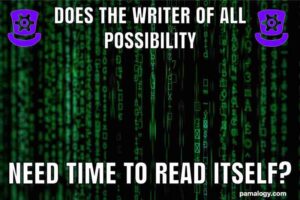
Truth is information. Truth is ideas – ideas that are independent of humans thinking them, or being aware of them. All possibilities continue to exist whether or not anyone is aware of them. I don’t have to imagine a purple poco-dotted cow with seven legs in order for that possibility to exist. In fact, if I were to try to imagine a similar cow but with ninety seven legs, I’d be so caught up in counting legs to make sure I had the right number in my mind’s eye, I probably couldn’t imagine it, but that wouldn’t mean that the possibility didn’t exist. The possibility of a ninety seven legged purple poco-dotted cow has always existed and always will in every Universe. All possibility always exists everywhere. And this is the reason that there is always something in nothing. Nothingness always possesses the fullness of possibility, regardless of location. It is always a constant – containing the same set of possibilities no matter where it is. It has never changed.
It is truth. It is all possibility. It is a constant. And it is information. Today, we’re going to be using the fact that abstract truth itself is information to open a door that exceeds the speed of light squared. If all possible information exists in all places, times and Universes, we’ve moved beyond quantum entanglement into an inconceivable Multiversal constant. The human brain can only begin to imagine hypothetical counterfactual possibilities. The Multiverse contains them always and everywhere and they have no variation or shifting shadow.
There’s been a lot of talk lately about simulation theory. The idea is that the Universe is comprised entirely of information. People speculate that we are living in something like the Matrix. When physicists look at sub-atomic particles, they start to find that some of the most fundamental building blocks of the Universe have no mass or energy. There is disagreement about this. Panels by the World Science Festival typically highlight differing points of view so you won’t want to miss their episode on Nothing or their episode on Simulation Theory for some introductory thoughts in a field with increasing depth.
But what I’m talking about here is quite different. For a simulation theorist, information actually requires some sort of building block involving energy, perhaps something used by a very intelligent designer that has set up the Universe like an interactive video game. Just as a computer simulation requires a little bit of processing power and moving about of the electrons, or even quantum particles, that give us our interactivity and monitor display, so also simulated Universes require some form of energy and possibly also some amount of matter or sub-atomic phenomena in order to operate.
This is the first thing most physicists will think about. They’ll ask how much energy is required for a simulation theory to be true.
But as I see it, information, raw information, the raw information of truth itself, doesn’t require mass or energy. It just is. What’s more, I don’t even advocate that the Universe is a simulation or even that it is comprised of nothing but massless, energy-free information. Instead, I’m here to explain the nature of nothingness in terms of all possibility – truth – which is information. Truth is everywhere. It is the same at all times and places.
All possibility is truth. It is a constant truth. And it is information. It is a concept. And it is a concept that does not require human beings, or machines, to process it or comprehend it, or for anyone or anything to realize it. And by “realize” here, I mean the difference between something being merely possible, and that possibility being actualized, made real. The possibility may be real, but the realization of that possibility, may not be real.
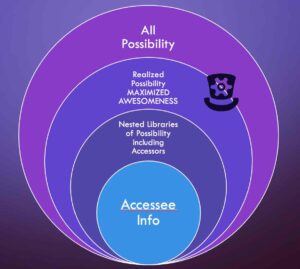
Let’s be precise. When I speak of reality, I’m making a distinction between things that happen in some dimension or Universe, and things that are merely possible. Possibility is a reality. That’s true. But I make a distinction between realized and unrealized possibility. Let’s do that. Some possibilities are realized. Other possibilities may not be realized. Truth includes all possibility, whether realized or not, anywhere or at any time in any Universe. And truth is real.
This means that no matter what the physicists have to say, truth exists everywhere as information at all times in every Universe and it is the same exact truth no matter where it is. Even perfect nothingness can’t escape it. However difficult it may be to create a true vacuum, escape from truth itself is even harder.
Assuming you’re following me on this, it should also make sense to you that truth itself, being pure information, is not limited to the speed of light the way particles and fields might be. Not only can it be in all places at once, it doesn’t need computing power to figure itself out. It doesn’t have to spend time computing what every possibility is and run into the inadequacies of our own ability as human beings to perform such a massive calculation, or list such an enormous set. Neither does it concern itself with an expanding Universe that is losing light beyond the horizon. It is there just as it is here. An expanding Universe may eventually make distant stars and galaxies too distant for us to detect, but we are always united with the entirety of the Multiverse through truth itself.
In my last episode, I described a multi-level nested digital library that contained multiple versions of ourselves in multiple Universes, accessing our own lives and being accessed. If awesomeness was to be maximized, that sort of nested library of reality definitely exists not just as a possibility, but as a truth that would be good – a truth that should be realized. My axiomatic statement – “if it would be good it’s true” would follow. In todays episode, my purpose in starting from nothingness, is to point to the nature of pure information – the fact that it does not need time or energy or phenomena, or laws or material of any sort to be fully processed. It simply is.
If you are following me, then you might guess that all this describes what we typically associate with God. Being truth. Being all places. Being inescapable. Being pure. Not being limited by time and space. Being unchanging. Being pure logic, or Logos, existing everywhere yet being outside of creation. These are all divine attributes. Right? But there are several things that are not divinity-like that are still in this picture, so I want to make sure you understand that that is not what I’m getting at – not yet.
To conclude that Maximized Awesomeness is necessarily true, we would have to defeat three very large elephants that remain in the room. Elephant number one is named, “Ex Nihilo.” It is the problem of going from pure possibility to reality. Steven Hawking and others seem to have solved this problem but that is debatable. Elephant number two is named, “Restrainer.” It is the problem of filtering out Maximized Awesomeness from every other possibility. Cosmologists often speak of the possibility of infinite worlds, but Maximized Awesomeness would require some way of filtering out evil from those worlds. Elephant number three is named, “Self-Understanding.” It asks what force might exist in pure possibility that would cause the use of such a filter and concludes that that force necessarily exists in the self-understanding of pure possibility itself. That’s what we’re going to talk about today.
In proving that Maximized Awesomeness is true, the subject of our free Pamalogy 101 course, we take these three large elephants in the room in backwards order so today we’re going to talk about the Self-Understanding of hyptothetical possibility. These blogcasts are a supplement to the Pamalogy 101 course. You won’t want to miss these three elephants. Plus, if you pass the course, I’ll send you a Pamalogy Top Hat. Then when people ask you where you got that cool hat, you can explain what Pamalogy is and tell them about these elephants.
You might have been asking yourself how it is I plan to pay for all these top hats. Well, since we’re on the subject of the somethingness that’s in nothingness, I’ll admit that the Pamalogy Society started from something that was in nothing. That is, I had thought of these concepts and developed the philosophical system we call pamalogy but they were just thoughts. I had no videos or books explaining it. I thought pamalogy was really cool, but I was driving an eighteen wheeler far far away from civilization at the time (from 2018 to 2020). The more I contemplated it out on the road, the more I felt the urgent need to share my thoughts. I came to believe that it was a form of gross injustice, in fact, that nobody in the world knew about pamalogy but me.
I realized that in order to share pamalogy, I would have to create a marketing mechanism but I had no resources. I was so broke, in fact, that I had to Uber during my days off over the road to pay bills. But it was at that time, that I found out what a great conversation starter my top hat was and how many times the subject of pamalogy was being discussed with my passengers. It was at that point that I added the sprocket of ingenuity to my hat. I had an idea. I believed that if I put together a free online course and anyone passed the course, they would have to understand what pamalogy was by the time they graduated. And if they did that, they would undoubtedly see the value in the Pamalogy Society. They would want to know more and to do more. The hat would be free, but I couldn’t see how they wouldn’t want to contribute to the cause. Having a top hat would then serve as their coversation starter, not just mine, and before long, I would have shared pamalogy with tons of people. The hats would pay for themselves through donations to the Society.
So there you have it. Something from nothing that had a lot of something. Our third elephant echoes this reality to the max. Remember its name: Self-Understanding. Is information in the form of pure possibility, the totality of abstract truth, whatever that is, capable of Self-Understanding? Is it capable of anything at all? We readily assume that pure ideas in themselves need conscious agents. Some people even believe that pure ideas don’t exist without conscious agents to think them. We think of consciousness and understanding in a very human way. But the only basis for that assumption is our own experience as human beings. When we started to consider whether computers might one day be capable of consciousness, the picture of what consciousness was started to change. It didn’t have to be biological. It could be mechanical. And really, its all just information and how information gets processed through patterns.
Ray Kurzweil, in an interview with Robert Lawrence Kuhn, said he didn’t see much reason for any distinction between information and reality. If the fundamental particles of reality are themselves merely comprised of bits of information, information is reality. But if pure abstract truth is a reality and reality is indistinguishable from information alone, then we already have our answer regarding our third elephant. The totality of possibility is capable of Self-Understanding because it is comprised entirely of information. The reason is pretty simple. In a Universe, there may well be laws of quantum physics and light speeds and magnetic and gravitational fields and so on, but in pure possibility, all that stuff is unnecessary. Our proof of the third elephant stems from the stuff of the elephant itself – its vast set of hypothetical possibilities – which is an incomprehensible set, comprised entirely of information and nothing else.
To know that pure possibility has Self Understanding, we need merely start enumerating some of the contents. For instance, every possible moment of you is a hypothetical possibility. It is information. It always was, even prior to your realization. But you are just one example among innumerable examples. Even the uncountable possible versions of you is tiny in comparison to all possibility. You belong to the total set of all that is possible as part of a set that you will never be able to count. For a human being, that would be impossible. But for the total set of possibility itself, counting all possibility is one possibility among many. This is true information. We know that the total set of possibility contains this – that all that is possible might be known by pure possibility itself – that all possibility might be Self-Aware, understanding Itself.
It would involve a mind much greater than our own, but it is a possibility. And if it is a possibility, it is information. And if there is no distinction between information and reality, then it is a reality. Therefore, if Ray Kurzweil is right, Maximized Awesomeness, which is also a possibility in the midst of the very vast set of all possibility, is also a reality as information. The fact that It would be Self-Aware might be beyond our comprehension, but it is nevertheless so. Awareness, and Self-Understanding, is something with many levels and possible expressions.
Kuhn, interviewing Nick Bostrom at the University of Oxford, runs into the logic that any civilization that becomes advanced enough not to destroy itself with its technology, either has no interest in using it to create simulated Universes with or does create them and even mass produces them. My argument from pure possibility as the total set of information, contains both the information describing the technology and the formula for the civilization itself. Bostrom’s imagery of advanced civilizations creating the simulations is akin to the image I offered in my last blogcast, of the multi-level nested library of data. Maximized Awesomeness, as Self-Understanding, is that conscious agent that contains within itself all other conscious agents, each comprised of information, each made technically feasible, through the speed of being everywhere at all possible times in the space required by nothingness, as that something, (a very huge something – all possibility), that is contained in all nothingness.
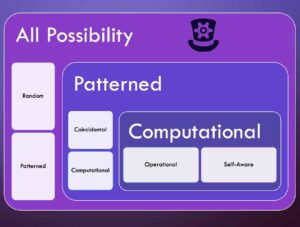
Kurzweil speaks of patterns of information. All possibility may be random, but patterns are not. Still, patterns do produce consciousness and they are not excluded from the total set of possibility. Thus if for Ray Kurzweil, the Universe is a computer, for the pamalogist, the Multiverse contains every pattern any computer could have. If patterned information is required, not just information, then all possibility does contain those patterns. If patterns of information create computational processes, then pure possibility, the total set of it, or subset of it, that contains patterned information, contains the basis of Self-Understanding, and indeed, all understanding and consciousness that could exist in any Universe.
We talk about fast computers and advancements in technology that might enable the simulation of Universes. Nothing is faster than being everywhere all at once at all times in every dimension in every Universe. Nothing is faster than that subset of possibilities that describes the best possible computational technology. Advanced civilizations are the result of this, not the cause. Bostrom says odds are that we, the simulated, far outnumber, those doing the simulating because of mass production. I agree. In the nested library system I’ve been describing, Maximized Awesomeness is one while we are many. But Bostrom fails to consider convergence. He doesn’t see a connection of identity between those accessing data from the Universes that have been simulated and those being accessed by them.
What drives speculation about a convergence like that is two-fold. First, convergence is a possibility. In other words, the person whose life is being accessed in a simulation may in some way be the same person as the person who is accessing them. When you look at a photo album that includes your own picture, you have a sense in which both the photo and you are representative of one person – you. Second, there is the question of whether something would be good. If such a convergence, such a sharing of identity between accessors and accesses in a Universe, would be a good thing, then the principle of Maximized Awesomeness, dictates that it would be true.
I haven’t gotten so far as proving MaximizedAwesomeness is true in this blogcast yet, but it’s always helpful to repeat what it means. It means both the inclusion of all that could possibly be good as part of Itself, and the absence of anything bad. So, if a convergence between an accessing you and an accessed you would be a good thing, so that both you as accessee and you as accessor were in some sense you, then if Maximized Awesomeness is true, then that convergence is true. Maximized Awesomeness contains all good things, contains no bad things. If there is evil in any Universe, it must be a mental construct of some sort, only for the purpose of making a good relationship to that evil possible so that all good possibilities can be realized.
It would be good if Maximized Awesomeness were true – Perfect even – Maximized Awesomeness is that than which there could be nothing better. That’s what pamalogy is all about. It creates many Universes, many astronomies, to realize all good possibility. It also regulates evil so that evil never happens. You may find this to be contrary to your experience and understanding. So, next time we’re going to return to the pamalogist’s theodicy and treat the problem of evil some more, looking more closely at its computational patterns. We have to sort out the difference between all possibility as information and all possibility as reality before we can tackle the second elephant. You will discover that there is a sense in which information is not necessarily reality. We’ve over-simplified the idea of the Self-Understanding of the total set of possibility as necessarily true in this blogcast by merely equating it with information. Next time you’ll see why there’s more to it. Ciao!
URL for sharing this transcript page https://pamalogy.com/2022/03/08/compatibilism/the-speed-of-nothing
URL for sharing this podcast: https://player.captivate.fm/episode/304db75a-fe70-42d2-8c3e-ee8761ea7483
URL for sharing just the audio file: https://podcasts.captivate.fm/media/fe19dbdd-0c9f-4144-ae3c-438f3952e079/episode13-the-speed-of-nothingness.mp3
Previous: Compatibilism
Up Next: Defeating Evil

